Mastering Your Amazon Fire Stick Remote Programming
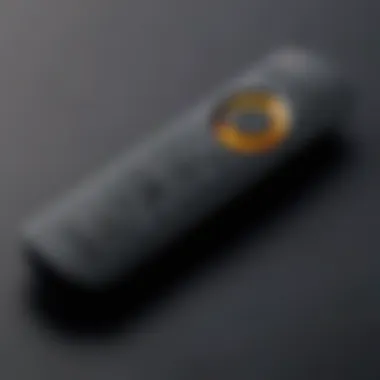
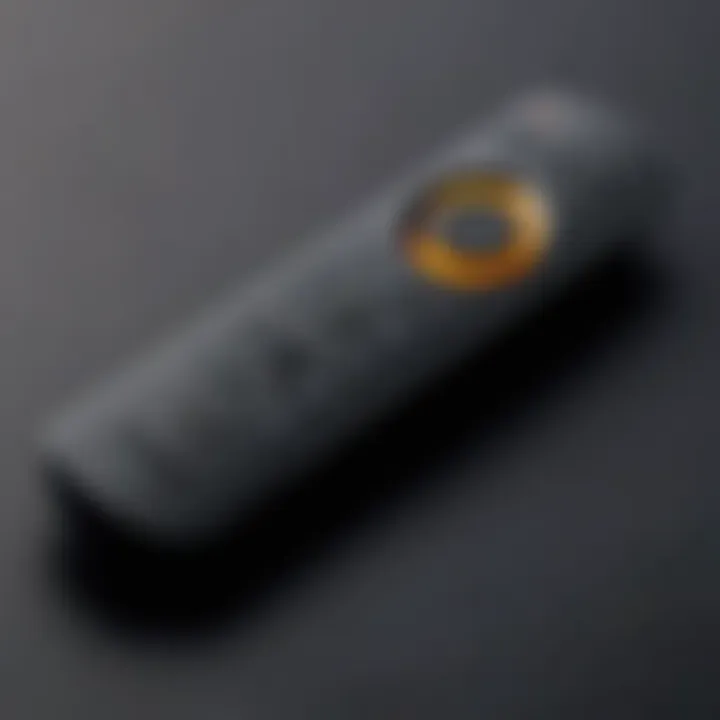
Intro
Programming an Amazon Fire Stick remote is a crucial aspect of maximizing your viewing experience. Whether you’re a tech enthusiast or a casual user, knowing how to set up the remote can significantly enhance your interaction with the device. This guide will detail the programming processes, covering various methods available, compatibility issues, and common challenges you might face.
It’s important to understand that not all remotes are created equal. Different Amazon Fire Stick models and remotes may have specific requirements and setups. Hence, having the right information at your fingertips is essential. This comprehensive approach ensures users can easily navigate through the programming steps while being aware of any hardware variations that might affect their experience.
Throughout this guide, you will find valuable insights into troubleshooting, which can often save you from unnecessary frustration when things don't work as expected. The ultimate goal is to empower you to take full advantage of your Fire Stick capabilities.
Understanding the Amazon Fire Stick Remote
To fully utilize the Amazon Fire Stick, understanding its remote is essential. The remote serves as the primary interface for navigation and control over the device. Without clarity on the functionalities, users may find it difficult to maximize the potential of their streaming media player.
Users should recognize that the Fire Stick remote operates beyond simple TV controls. It integrates with various services and features, enriching the overall viewing experience. Understanding how it connects and operates can illuminate troubleshooting processes, making it easier to resolve issues.
Overview of the Amazon Fire Stick
The Amazon Fire Stick is a compact streaming media player that plugs into the HDMI port of a television. It allows users to access a wide array of streaming services such as Amazon Prime Video, Netflix, Hulu, and many others. This device is designed to make streaming content straightforward and accessible.
The setup is relatively easy. Users need to connect the Fire Stick to the TV, connect it to Wi-Fi, and start their chosen streaming service. The interface is designed to be user-friendly, which enhances the overall experience. Therefore, understanding the Fire Stick complements the knowledge of the remote controls.
Features of the Fire Stick Remote
The Fire Stick remote boasts several features that significantly enhance user interaction:
- Voice Control: Many models come with Alexa integration, allowing users to search for content and control playback through voice commands.
- Shortcut Buttons: Remotes typically include dedicated buttons for popular applications, providing quick access to favorite services.
- Ergonomic Design: The remote is designed for comfortable handling, which aids in prolonged usage.
- Power and Volume Control: Some models allow users to control the TV's power and volume, reducing the need for multiple remotes.
These features reflect the intention behind the Fire Stick remote: to provide a smooth, multifunctional interface that enhances user experience.
Types of Amazon Fire Stick Remotes
Amazon offers a variety of remotes suitable for different needs.
Basic Remote
The Basic Remote is a straightforward device designed for essential navigation through the Fire Stick interface. Its simplicity makes it suitable for individuals who prefer not to engage with advanced features.
One key characteristic of the Basic Remote is its affordability and ease of use, making it a common choice among casual users. The lack of complex buttons or features is an advantage for those who do not need extensive functionality. However, its limitations may be evident to tech-savvy users seeking advanced control options or integration with smart home devices.
Voice Remote
The Voice Remote stands out due to its voice command features. Users can engage with content using their voice, making it a valuable tool for those who enjoy hands-free operation. The integration of Alexa enhances the remote’s capabilities by allowing users to search for titles, check the news, or control smart home devices.
This remote offers significant benefits, particularly for users who find typing cumbersome. However, some might view the reliance on voice commands as a drawback if voice recognition does not work consistently. Overall, the Voice Remote provides an additional layer of functionality, ensuring that users can engage with their media in a more dynamic way.
Understanding the types of remotes available is crucial for selecting the right one that aligns with individual preferences and needs.

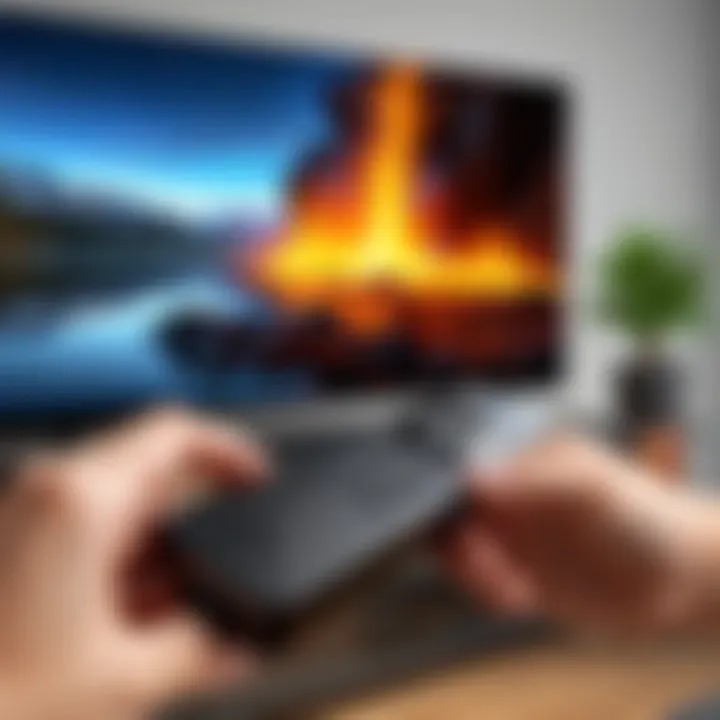
Preparing to Program the Remote
When it comes to programming the Amazon Fire Stick remote, preparation is key. Taking the time to prepare ensures a smoother experience and reduces potential issues during the programming process. By understanding the steps involved in preparation, users can set themselves up for success and enhance their overall streaming experience. Efficient preparation not only saves time but also contributes to a frustration-free setup.
Gathering Necessary Equipment
Before diving into the programming process, it is essential to gather all necessary equipment. The primary items needed include:
- Amazon Fire Stick: Ensure that the device is plugged into the TV and powered on.
- Remote Control: The physical remote that comes with the Fire Stick.
- TV and HDMI inputs: Check that the TV is turned on and set to the correct input channel.
- Wi-Fi Connection: A stable internet connection is necessary for software updates and streaming.
Having these elements ready will facilitate the programming process, making it more effective. Users should also ensure that the remote has functioning batteries. Non-functioning batteries are a common issue that can lead to misunderstandings during the setup.
Ensuring Device Compatibility
Compatibility between the remote and the Fire Stick is another critical factor to consider. Not all remote models work seamlessly with every version of the Fire Stick. Users should verify the following:
- Check Remote Type: Determine if your remote is a basic or voice remote and ensure it matches the Fire Stick model.
- Update Firmware: Keep the Fire Stick software updated to the latest version to avoid compatibility issues.
- Device Pairing: Be aware that some remotes may require a specific pairing process tailored to device models.
By ensuring compatibility ahead of time, users can avoid potential setbacks in the programming process. If a remote is not compatible, it may lead to frustration and wasted time. Always consult the user manual or Amazon's support website for guidance on which remote works with specific Fire Stick models.
Programming the Amazon Fire Stick Remote
Programming the Amazon Fire Stick remote is a crucial skill for users who want to optimize their streaming experience. Proper setup makes accessing content more convenient and can enhance overall usability by streamlining navigation and control. This section will explain various programming methods, and their specific benefits. Understanding how to program the Fire Stick remote can unlock features that may otherwise remain hidden to the casual user.
Standard Pairing Process
The standard pairing process is fundamental for users who just acquired the Fire Stick or wish to reset their current remote. To begin, users must ensure their Amazon Fire Stick is powered on and connected to the television. Next, taking the Fire Stick remote, press and hold the Home button for about 10 seconds. This action establishes a connection with the device, allowing the remote to communicate with the Fire Stick.
If the remote pairs successfully, a confirmation message appears on the TV screen. In situations where pairing fails, users might need to replace the batteries and repeat the process. Familiarity with this method ensures that even in cases of remote malfunction, users can restore functionality without excessive hassle.
Using the Fire TV App to Program
The Fire TV app is an alternative and effective way to program the Amazon Fire Stick remote. This mobile application is available on both Android and iOS devices, allowing users to control their Fire Stick remotely. To utilize this method, first download the app from the relevant app store. Ensure that the smartphone or tablet is connected to the same Wi-Fi network as the Fire Stick.
Open the app, and select the Fire Stick device from the list. After that, tap on Remote within the app. This feature simulates the physical remote, offering users a familiar interface. Additionally, it supports voice commands for fast access to various features. This method not only simplifies the programming process but also serves as an excellent alternative if the physical remote is misplaced.
Connecting to Other Devices
Connecting the Amazon Fire Stick remote to other devices such as sound systems or televisions is another important aspect of programming. This capability enhances overall entertainment experience by allowing one remote to control multiple devices. To achieve this, users should follow the given steps.
- Navigate to the Fire Stick settings.
- Select Equipment Control and then Manage Equipment.
- Follow the prompts to add the device, ensuring that they are powered on and within range.
This feature makes it possible to control additional devices directly from the Fire Stick remote. Users can enjoy seamless integration with smart televisions and sound systems, contributing significantly to their home entertainment setup.
By learning these methods, users can make the most of their Amazon Fire Stick remote. Optimal programming is not only about convenience; it allows for enhanced control and an overall improved viewing experience.
Troubleshooting Common Issues
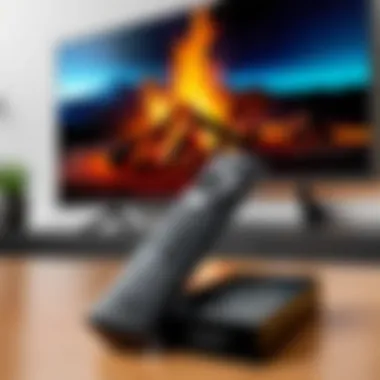
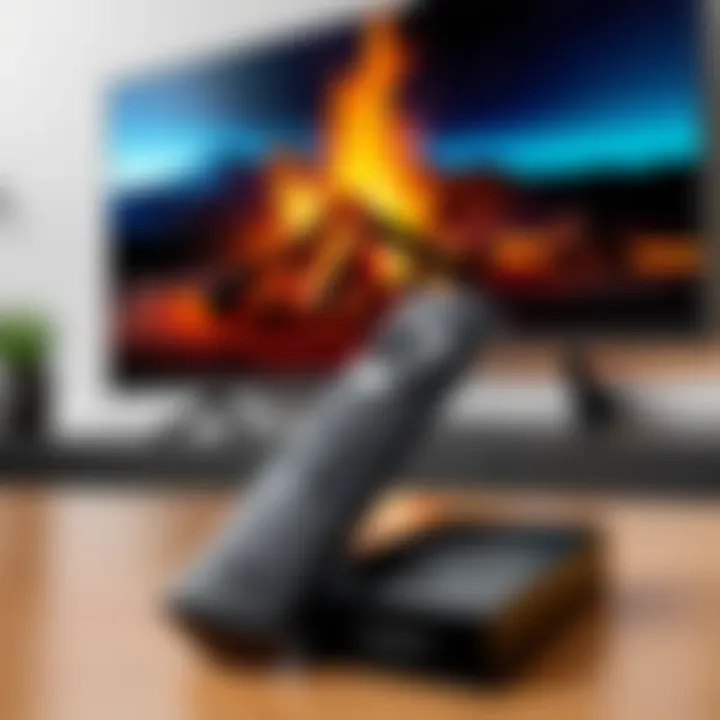
Troubleshooting is crucial when working with technology, particularly with devices like the Amazon Fire Stick remote. This section aims to address common problems users may encounter, providing practical solutions that enhance the overall user experience. Understanding and resolving these issues ensures smooth operation, allowing users to make the most of their Fire Stick and enjoy seamless media consumption.
Remote Not Responding
A common complaint among Fire Stick users is that the remote does not respond. This issue can stem from several factors. Firstly, confirm that your Fire Stick is powered on. Sometimes, users forget to turn on their devices. If the Fire Stick shows signs of being on but the remote is unresponsive, check the batteries. Weak or dead batteries are frequent culprits.
If changing the batteries doesn't work, try resetting the remote. To do this, press and hold the "Home" button for about ten seconds. This action can help re-establish the connection between the remote and the Fire Stick. In some cases, removing the remote from the device's Bluetooth list and pairing it again resolves the issue.
Connection Problems
Connection problems can interfere with how the remote communicates with the Fire Stick. If your remote shows connection issues, start by ensuring that there are no obstacles between the remote and the device. Sometimes, physical objects can obstruct the infrared signals. If possible, remove any barriers and try again.
Another potential issue could be Wi-Fi problems. Ensure your Fire Stick is connected to a stable network. If the connection seems weak, try rebooting your modem or router. Restarting the Fire Stick can also help reset any network-related issues. To do this, unplug the device, wait for around 30 seconds, and then plug it back in.
Battery Issues
Battery-related concerns are also prominent when it comes to using the Fire Stick remote. It is essential to use high-quality batteries designed for longevity. Cheap batteries can lead to quick-draining issues, resulting in a remote that frequently runs out of power. When replacing batteries, make sure to install them correctly according to the polarity markings inside the battery compartment.
Additionally, it’s wise to regularly check the battery levels within the Fire Stick settings. Keeping track of battery health can prevent sudden interruptions during use. If you notice inconsistent performance even after replacing batteries, it may signal a need for a remote replacement.
"Regular maintenance and troubleshooting can greatly enhance your experience with electronics like the Amazon Fire Stick remote."
By keeping these common troubleshooting issues in mind, users can quickly address problems and enjoy a more fluid experience. Whether it is a remote not responding, connection hiccups, or battery troubles, understanding these aspects can prevent frustration and ensure a more enjoyable viewing time.
Maximizing Fire Stick Remote Utility
Understanding how to maximize the utility of the Amazon Fire Stick remote is crucial for enhancing your overall viewing experience on this powerful streaming device. This section will delve into various aspects that enrich the functionality and personalization of your remote, making your interaction with the Fire Stick more seamless and enjoyable. The features and options available not only increase efficiency but also cater to user preferences, thus improving the accessibility of the device.
Voice Control Features
Voice control on the Fire Stick remote adds a layer of convenience that transforms how users interact with their devices. With Alexa, the built-in voice assistant, users can search for content, control playback, and even manage smart home devices simply by speaking. This eliminates the need for scrolling through menus, making content discovery quicker and more intuitive.
To utilize voice control:
- Activate Alexa by pressing the microphone button on the remote.
- Issue commands such as "Play [Show Name]" or "Search for action movies."
- Access smart home controls by saying, "Turn off the living room lights."
Voice control significantly enhances the user experience, removing barriers associated with traditional remote controls.
However, the efficacy of voice commands can depend on the clarity of the microphone and the noise levels in the environment. Users should keep this in mind when making selections through voice activation.
Customization Options
Customization options available for the Fire Stick remote allow users to personalize their device according to individual preferences and needs. This flexibility not only makes navigation easier but also enhances user satisfaction. Features like programmable buttons, app shortcuts, and even remapping controls can lead to a more efficient experience.
Here are some customization options:


- Programmable Buttons: Users can assign specific functions to certain buttons, allowing for quick access to frequently used features.
- App Shortcuts: Popular apps can be added to custom settings, enabling faster launches without searching through menus.
- Keyboard Layout Adjustments: Users can select their preferred keyboard layouts for text input, improving usability for applications that require typing.
By employing these customization options, users can tailor their remote to better fit their viewing habits. This personalization can dramatically affect how enjoyable the streaming experience is, making every session more engaging.
In summary, maximizing the Fire Stick remote's utility through voice control features and customization options provides not only practical benefits but also aligns with the demands of a tech-savvy audience. Understanding these capabilities empowers users to fully utilize their devices, resulting in a fluid viewing experience.
Safety and Maintenance Tips
Understanding the importance of safety and maintenance tips for your Amazon Fire Stick remote enhances both its longevity and performance. Proper care ensures that your remote functions optimally without leading to any avoidable damage. Direct exposure to adverse conditions can impact the functionality of the remote, making it crucial to implement protective measures.
Protecting Your Remote
To prolong the lifespan of your Amazon Fire Stick remote, consider the following protective strategies:
- Use a Case: Investing in a protective case can prevent scratches and damage due to accidental drops. Many options are available in the market, specifically designed for the Fire Stick remote's dimensions.
- Avoid Liquids: Water and electronics do not mix. To keep your remote safe, place it away from potential spills or moisture. If the remote ever gets damp, ensure it is dried thoroughly before use.
- Keep Away From Heat: Avoid exposing your remote to direct sunlight or high heat sources. Excessive heat can warp the plastic materials or damage the internal components, leading to malfunctions.
Implementing these strategies can mitigate risks and contribute to the remote's overall durability.
Regular Maintenance Practices
Regular maintenance of your Amazon Fire Stick remote contributes to its efficient performance. Here are some best practices:
- Battery Replacement: Regularly check the battery status. Replace old batteries with fresh ones to avoid connectivity issues. Be sure to use recommended battery types for optimal operational efficiency.
- Clean the Remote: Dust and debris can accumulate on the remote, affecting button functionality. Use a soft, damp cloth to clean the surface, and avoid using chemical cleaners.
- Storage: When not in use, store the remote in a designated spot to avoid misplacement. Keeping it stored safely can also prevent accidental damage from being stepped on or crushed.
By consistently following maintenance practices, you retain the reliability of your Amazon Fire Stick remote, allowing for an elevated viewing experience.
"A well-maintained remote enhances user experience by providing uninterrupted access to entertainment."
In summary, taking the necessary steps to protect and maintain your Amazon Fire Stick remote ensures not just its functionality, but also the longevity of your device. Investing time in safety and maintenance yields benefits that enhance your overall streaming experience.
Epilogue and Future Considerations
This section provides closure to the comprehensive guide on programming the Amazon Fire Stick remote. It consolidates the essential programming steps detailed throughout the article. Moreover, it examines the significance of continuous updates and how they can enhance user experience and functionality.
The importance of effectively programming your Amazon Fire Stick remote cannot be overstated. A well-functioning remote ensures that users can navigate their devices effortlessly, interacting smoothly with various apps and features. As technology evolves, so do the methods to program these devices. Keeping abreast of programming steps allows users to troubleshoot efficiently and adapt to new functionalities.
Recap of Programming Steps
To summarize the programming steps for the Amazon Fire Stick remote, consider the following:
- Gather required devices: Ensure you have all necessary equipment ready.
- Determine compatibility: Confirm that your remote is compatible with your Fire Stick model.
- Pair the remote: Follow the standard pairing process to connect the remote to your device.
- Utilize the Fire TV App: Leverage the Fire TV app for additional programming options and features.
- Connect other devices: If needed, connect the remote to different TVs or devices for an enhanced experience.
This streamlined process can vastly improve user engagement with the Fire Stick. It ensures that the remote is synchronized properly and ready for seamless navigation.
Prospects for Future Updates
Looking forward, the prospects for future updates to the Amazon Fire Stick remote and its functionalities are significant. Tech companies continue to emphasize user experience, and Amazon is no exception.
Future updates may include:
- Enhanced Voice Control: As voice command technology advances, expect more responsive and intuitive voice control options.
- Integration with Smart Home Devices: Future remotes may offer better integration with a variety of smart home products.
- Improved Customization: Users might gain greater flexibility in customizing their remote settings based on personal preferences.
Understanding that these updates will become accessible will empower users to maximize their Fire Stick experience. It is essential for users to stay informed about developments, as these can drastically affect how they interact with their devices.



